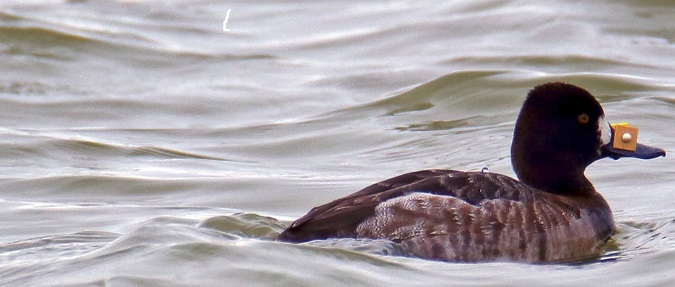
The individual in the picture was banded as a duckling in 2008 and subsequently recaptured and nasal marked in 2011. The nasal marker does not affect adult female survival, and the female’s bill is not punctured. There is no septum between the holes in the bill of a duck, so the small pin that holds the two discs on simply slides right through. Photo by USFWS
Visitors to Red Rock Lakes National Wildlife Refuge may be treated to a rather strange sight during future visits: a duck with a nose ring.
Say what?
That’s right. Researchers are conducting a long-term demographic study of female lesser scaup at the refuge, which supports one of the highest recorded densities of nesting lesser scaup in North America.
The nasal marker, applied in 2011, allows the duck to be easily identified at a distance if she returns to the study site, providing researchers with valuable survival data.
Why go to all this trouble, you might ask?
Across the 11 states of the arid Intermountain West, wetlands are very scarce resources, comprising less than 2 percent of the total area. And nearly 90 percent of wetlands in the region occur on just 10 percent of the land area. If you are a duck in search of water, pickings are slim and far apart.
Researchers know that this female and other ducks across the region need wetland connections. But what this study revealed is the critical importance of female pre-breeding body condition on if, and when, she nests. The earlier she can nest, the more likely she is to successfully fledge young.
The study also demonstrated the cost of that success can be high. When local wetland conditions are good, many females nest successfully and female survival during the breeding season increases. The unfortunate result of this success comes the following winter – female survival during non-breeding seasons is lowest after a breeding season with good wetland conditions. Conversely, during dry breeding seasons, when many hens choose not to nest, survival during the following non-breeding season is higher.
The relationship is likely a result of females investing significant amounts of energy raising a brood in good wetland conditions. They end the breeding season in poor body condition — just when they need to molt feathers and build fat reserves for fall migration, both costly annual events. When females begin these activities late in the breeding season, and in poor body condition, researchers believe it is more difficult for them to prepare for the fall migration, which has a direct and negative impact on their survival rates.
So, what can we do?
Maintaining, improving and restoring wetland connections for when females start heading back south is one of the most important activities we can take. These birds use state and federally managed ‘semi-permanent’ wetlands (i.e., those with open water throughout the growing season in most years) across the Intermountain West as gas stations to ”top off” their tanks during migration, allowing them to rest and recover from their travels. These publicly owned and managed wetlands comprise more than 60 percent of semi-permanent wetlands in the region, creating the connections migratory birds need to travel between breeding and wintering grounds.
Quality management of these wetlands provides the fuel for migration and keeps these linkages intact, so the cycle can repeat itself next year.
And it all begins with data derived from a duck’s nose ornament – ain’t wildlife conservation grand!
Brian Allen, Fish Springs National Wildlife Refuge, Mountain-Prairie Region; Jeff Knetter, Idaho Department of Fish and Game; Josh Vest, Intermountain West Joint Venture; Jeff Warren, Red Rock Lakes National Wildlife Refuge, Mountain-Prairie Region
